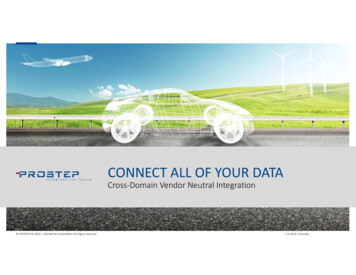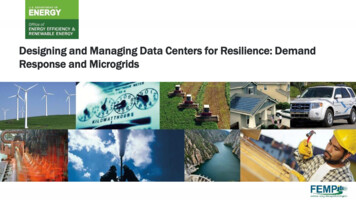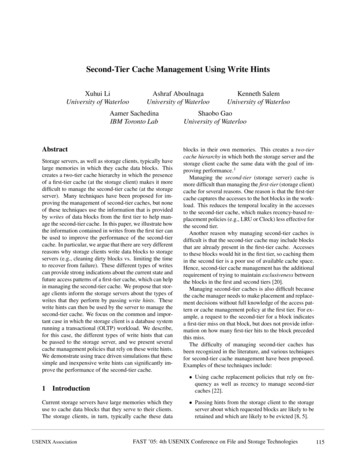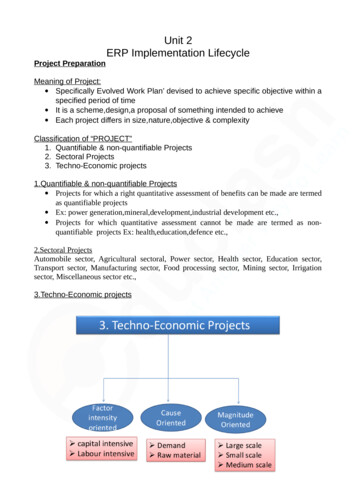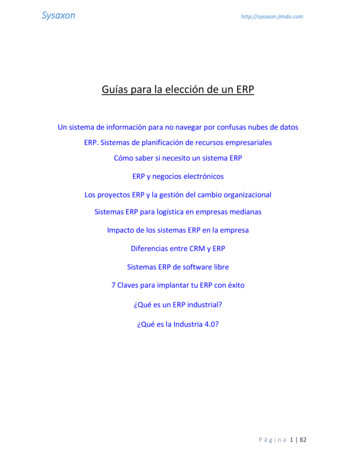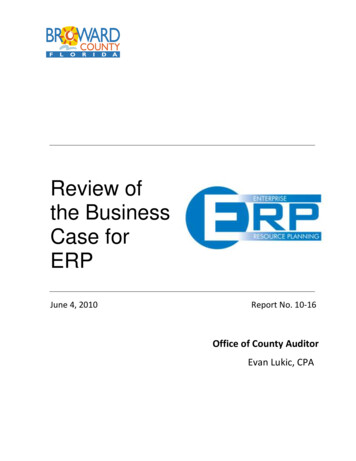
Transcription
TWO TIER ERP SYSTEMS: COMBINATION OF ONPREMISE AND CLOUD Cloud ERP ManufacturingService OutsourcingInformation Systems ScienceMaster's thesisMarlon Machal2013Department of Information and Service EconomyAalto UniversitySchool of BusinessPowered by TCPDF (www.tcpdf.org)
TWO TIER ERP SYSTEMS: COMBINATION OF ON PREMISE AND CLOUDCloud ERP Manufacturing Service OutsourcingMaster s thesisMarlon MachalMay 15th , 2013Information and Service ManagementApproved in the Department of Information and Service Economyand awarded the grade1st inspector’s first name family name2nd inspector’s first name family name
AALTO UNIVERSITY SCHOOL OF ECONOMICSABSTRACTMay 15th, 2013Department of Information and Service EconomyMaster’s thesisMarlon MachalABSTRACTObjectives of the StudyThe objective of this study is to expand the knowledge of the existing studies related to cloudcomputing. The results will be presented as a figure which will illustrate the ERP integration of onpremise and the cloud. It will give an idea to the new customers of ERP systems on how to dealwith two-tier ERP systems (cloud and on-premises) as well as to enhance understanding of ERPservices that can be carried on their premises and what ERP services can be outsourced over thecloud.Cloud ERP is quite a new, unclear and broad concept, since all the studies related to it are recent.Almost all cloud ERP providers describe their products as straight forward tasks. But, it stillremains unclear how companies can outsource ERP services over the cloud.This paper focuses on such ERP services that can be outsourced over the cloud, as well as the risksassociated with any data or information that will be moved from in-house into the cloud.Findings and conclusionsERP providers, IT consultants and manufacturing companies have confirmed that there are nodifferences between cloud ERP and on-premises ERP. Both ERP types contain similar modules.ERP in cloud or on-premises will serve same defined business needs.Not all data will be moved to the cloud under cloud ERP. In a similar way not all of the services canbe outsourced over the cloud using cloud ERP. The data security is the top priority of all cloud ERPproviders, IT consultants and manufacturing companies.Cloud ERP involves several partners that serve the same customer of an ERP system. Data safety isthe responsibility of all the partners involved in delivering ERP over the cloud.KeywordsManufacturing Companies, Cloud, ERP on-premises, Cloud ERP, ERP Providers, It Consultants,Service Outsourcing and Data Risk ManagementI
AcknowledgementsThis thesis would not have been possible without the supervision of Professor Markku Tinnilä andguidance of Professor Matti Rossi who are well known with their generous help and support fortheir students. Special thanks to Mrs. Anne Kankaanranta who helped me to build this thesis,without forgetting to thank the ISM assistant Seppo Mallenius for his great support and help inthesis seminar.I am very grateful to all of the IT consultants, manufacturing companies, ERP implementers andproviders for their time and interview contributions.II
TABLE OF CONTENTSABSTRACT .ITABLE OF CONTENTS . IIILIST OF FIGURES .VILIST OF TABLES . VII123Introduction . 11.1Defining cloud ERP. 21.2Defining cloud outsourcing . 61.3Background for the research. 71.4Research questions and objectives of the research . 91.5Structure of the study . 10Methodology . 122.1Research design . 122.2Data collection . 122.3Target groups . 13Literature review of ERP on-premises and cloud ERP services . 143.1ERP based on on-premises business model . 143.2Traditional ERP life cycle . 163.3ERP based on SaaS business model . 193.3.1ERP as SaaS . 203.3.2Cost of ERP SaaS vs. cost of ERP on-premises: practical example . 223.44Summary . 23Cloud computing service outsourcing. 244.1Current cloud outsourcing . 244.2Benefits of cloud ERP service outsourcing . 264.2.1Alleviating risks . 274.2.2Service cost saving . 27III
4.2.3Easy access . 284.2.4Dashboard . 284.2.5Focus on core business . 294.2.6Implementation . 294.2.7Data safety. 304.3Issues and concern related to cloud ERP outsourcing . 314.3.1Security . 314.3.2Data control . 334.3.3Cloud ERP vendor or cloud ERP provider selection . 344.3.4Added application . 364.3.5Cloud ERP response. 364.3.6Costs . 374.3.7Vendor lock-in . 374.4Cloud ERP life cycle . 384.5Summary . 395Framework . 416Data gathering . 446.1Articles, social media and IT consultant interviews. 446.2Midsized and small business companies . 506.3Cloud ERP providers . 526.3.1SAP cloud ERP provider. 526.3.2Oracle cloud ERP . 586.3.3Visma cloud ERP . 616.4New ERP customers . 636.5Hidden patterns. 646.5.1Tool . 646.5.2Results . 65IV
6.678Summary . 66Findings and discussions . 687.1Companies . 687.2Consultants . 707.3Cloud ERP providers . 727.4Summary . 75Conclusion . 778.1What are ERP services that can be outsourced over the cloud? . 778.2What ERP data can be kept on premise and what can be moved to the cloud? . 818.3How safe is cloud ERP compared to on-premises ERP? . 838.4Reflections to earlier research . 868.5Limitations of the study. 878.6Suggestion for further research . 88REFERENCES. 891.1Books, articles, interviews and reports . 891.2Online references . 93APPENDICES . 101Appendix 1- RapidMiner s used operators in this thesis. . 101Appendix 2 - RapidMiner with the predefined operators . 103Appendix 3- transformation and processing of data . 103Appendix 4 - Terms with highest support values that are associated to cloud ERP and onpremises ERP services . 104Appendix 5 - the results of hidden patterns generated from each category :companies, consultantsand cloud ERP providers. 105Appendix 6 - Interview questions . 107V
LIST OF FIGURESFigure 1-1. Cloud computing three stacks . 3Figure 1-2. Different types of Clouds . 5Figure 3-1. Typical ERP system modules . 16Figure 3-2. On-premises ERP lifecycle . 17Figure 3-3. Long-term misalignment of ERP system. . 18Figure 3-4. Reason for budget overruns. 19Figure 3-5.ERP as SaaS offered from Provider via internet on the cloud. . 21Figure 4-1. Important factors that drive cloud computing services compared to the alreadyimplemented cloud computing services . 25Figure 4-2. Current and expected future uses of services outsourcing . 26Figure 4-3. Four-Year Total Ownership Cost Distribution (TCO), Comparison: On-Premise ERP vs.SaaS ERP for Mid-Market Enterprises . 27Figure 4-4. Players involved in cloud if the cloud is used as metaphor of internet . 31Figure 4-5. The security issue rises due to the external connection . 33Figure 4-6. ERP providers market share in 2010 . 35Figure 4-7. Cloud ERP life cycle. . 39Figure 5-1. Empirical study framework . 43Figure 6-1. Cascading failover configuration: data recovery over the cloud. . 47Figure 6-2 . The price of SAP ERP on-premises system . 52Figure 6-3. Integrated Sales and Distribution Processes and integrated Marketing-to-OpportunityProcesses as well as Operational Procurement Process Flow . 56Figure 6-4. Increasing in buying decisions before visiting store . 57Figure 6-5. Benefits of Oracle storage services over the cloud. . 60Figure 8-1. Map view of the suggested cloud ERP outsourced services. Adopted from the finding ofthis thesis . 81VI
LIST OF TABLESTable 3-1. Prices comparison of ERP on-premises and ERP on the cloud . 22Table 3-2. Annual cost saving when customer choose Cloud ERP over on-premise ERPP . 23VII
1IntroductionThe purpose of this paper is to clarify several ambiguities which surround the cloud ERP and theon-premises ERP systems. The main idea is to shed light on trade-off between cloud ERP and ERPin the companies’ premises based on cloud outsourcing services, focusing on small and midsizedmanufacturing companies.Various Enterprise Resource Planning (ERP) providers have proved that ERP has improved thequality and efficiency of numerous companies businesses. ERP systems also provide a real timesupport to managerial decision making. Most of the ERP systems combine all departments andbusiness functions of the entire company into a single shared system. An ERP system helpscompanies to manage and integrate business activities such as planning, purchasing, inventory,sales, marketing, finance, human resources, etc. ERP enhances company s agility and flexibilityallowing different parts of the company to communicate with each other, sharing information andbecoming more cohesive. The ERP system is usually installed in the companies computer networkinfrastructure.Nowadays, cloud technology has shifted the management of hardware and software to the cloudservices provider. Most of business applications are and will be moving into cloud-basedcomputing, due to the ubiquitous of internet devices that range from smart phones to all type ofother internet devices.The next step of cloud computing has and will offer new ways to collaborate everywhere throughany internet-connected computer or internet mobile devices. I learned in Business Intelligence,(Rossi, 2012), and ICT Enabled Business Process Development courses (Penttinen, 2011), thatcloud application users can just open an internet browser, log in, customize their applications, andstart using it anywhere at any time. The idea is similar to Software as a Service (SaaS), this termSaaS defined software being delivered as service method that offers access to software functionsremotely as a web based service. The idea behind it is to use specific software at less cost withoutpaying for the full license or owning the software.1
Based on cloud solutions, ERP providers have recognized that companies have understood thatinvestments in hardware and software are no longer a necessity. This will open new businessopportunity for ERP cloud providers to offer new ERP outsourced services. Therefore due to lowcosts of cloud services and security issues, companies will find themselves dealing with two tierERP systems as a combination of on-premise and cloud. This has increased an interest in cloudcomputing that has created a need and interest to explore cloud-based ERP systems and try toemphasize the ERP services that can be outsourced over the cloud.In order to understand cloud ERP and service that can be outsourced over the cloud, it will beconvenient to define and explain cloud ERP and cloud outsourcing.1.1 Defining cloud ERPThe purpose of cloud ERP is derived from the cloud computing concept. To understand what cloudERP means, it will be necessary to first define cloud computing. Miller (2008), described cloudcomputing based on cloud term which is seen to be numerous computers and servers interconnectedvia internet. Computers can be personal computers or network servers; they can be public orprivate. According to Jennings (2009, 3), the term cloud computing implies access to remotecomputing services o
premise and the cloud. It will give an idea to the new customers of ERP systems on how to deal with two-tier ERP systems (cloud and on-premises) as well as to enhance understanding of ERP services that can be carried on their premises and what ERP services can be outsourced over the cloud.
